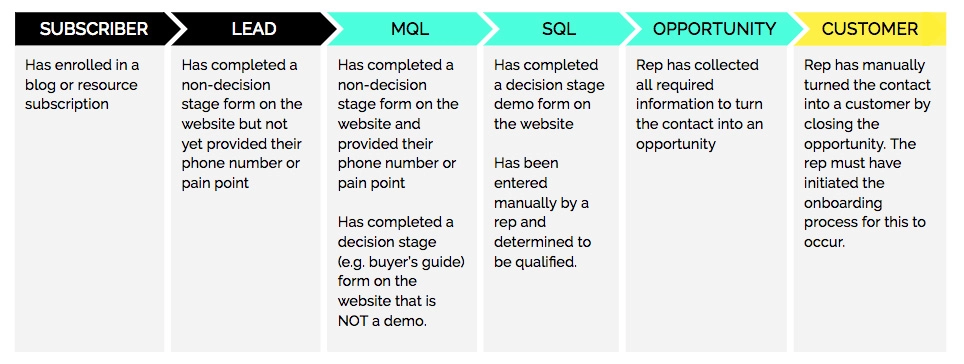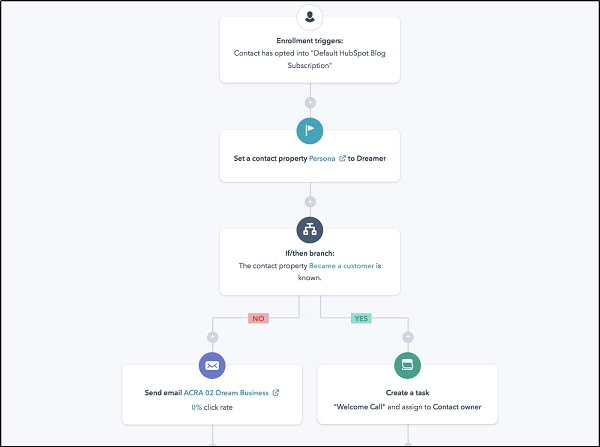
Introduction
Generating leads is one of the most important activities that B2B marketers are engaged in. Without doing so, the company will struggle to generate sales revenue and even grow.
B2B companies need solid lead generation strategies. In the absence of one, they’ll struggle to identify prospects because they lack clarity about the kind of people they need to attract and sell to.
Once a lead generation strategy is in place, companies start attracting marketing qualified leads (MQLs). However, this alone is not enough. MQLs have to be pushed down the sales funnel to become sales qualified leads (SQLs) for deal closure to happen.
By definition, MQLs are primarily contacts that are not quite ready for personal or direct attention from the sales team. On the other hand, SQLs are contacts that are ready for direct follow-up from the sales teams as reflected in the image below.

Ideally, companies should always prioritize interactions with leads that are close to the end of the sales funnel – the SQLs. But when it comes to qualifying MQLs into SQLs and passing them down to the sales teams, every company has its own process.
To do this, B2B companies must undertake one of the most critical steps in the selling process – determine the quality of their MQLs and the stage they are on the purchase journey. This information facilitates streamlining of qualifying MQLs to SQLs.
So, what steps should B2B marketers take in qualifying MQLs into SQLs before passing them to them to sales reps?
5 Steps for Qualifying MQLs Into SQLs
1. Encourage MQLs to Download Your Whitepapers
As MQLs interact with your business, they’ll be looking for solutions to their problems
Whitepapers become useful tools for qualifying MQLs for various reasons including:
- Providing them with in depth studies of different topics
- Advocating for specific solutions or position
- Educating prospects as they go through the process of making decisions
- Sharing technical industry knowledge
- Publicizing the products or service offerings that a company offers
- Position your company as a thought leader in its industry
Beyond this, whitepapers enable B2B companies to capture lead data including:
- Names of leads
- Name of the company
- Country
- Email address and
- Phone numbers
With this information, B2B marketers can segment their audience as well as target those audiences with relevant, targeted content.
2. Run an Automated Nurturing Programme
MQLs need to be nurtured down the sales funnel to qualify as SQLs
With 67% of B2B buyers purchasing journeys happening in the digital space, running an automated lead nurturing campaign becomes critical for every company that is keen to qualify MQLs into SQLs.
Statistics show that the best way to automate B2B lead nurturing processes is through email marketing. This is because 86% of B2B professionals prefer email communication. Also, emails that are sent as result of an action taken by prospects are 3 times more effective than drip or nurture emails.
In very basic terms, email marketing campaigns involve targeting prospects and customers via email. In the lead nurturing context, email marketing becomes a useful tool for giving prospects the valuable information they need to move down the sales funnel.
To nurture MQLs using email marketing automation, B2B companies will need to:
A. Know What Your MQLs Need
The success of any email marketing campaign depends on how relevant the content of emails is to recipients. Like any other marketing efforts, the buyer persona is the best place to start when nurturing MQLs. By using buyer personas, B2B companies get to know what their target audiences want and customize their emails to their needs.
B. Benchmark Your Lead Nurturing Goals
Having clear lead nurturing goals enables you to focus your efforts. The best way to set realistic goals is to gather information about your context. For instance, conduct some research on email stats in your industry and use that data to set lead nurturing goals.
C. Pick an Email Marketing Service
One of the resources you need to invest in to run an automated lead nurturing campaign is an email marketing service. With such a service, you’ll be able to create efficient emails, personalize them and even optimize them with a professional look without having to hire designers or IT personnel. There are various features that can help you create great lead nurturing campaigns on email. These include:
- Easy-to-build landing pages, CTAs and forms
- CRM segmentation capabilities
- Automation and email regulations compliance
- Email split tests
- In-built email analytics and reports
D. Craft Catchy Emails
To nurture MQLs, you need to keep them hooked and interested in your brand. One of the most effective ways to do this is paying attention to email content. Here are some useful tips on how to run a successful lead nurturing campaign on email:
- Automate emails so they’re sent when they’re likely to be opened. Studies show that the best time and day to send emails is Tuesdays at 11am.
- Maintain a consistent voice in your emails and avoid discussing multiple topics in a single email
- Use relevant, eye-catching emails that are optimized for different devices
- Make your Call-to-Actions standout in emails and ensure that they are directed to relevant pages or offers
- Optimize your emails for mobile devices as 55% of emails are accessed via such devices
- Personalize your emails by addressing readers by name and in a tone that is familiar
- Write personalized subject lines that are enticing, actionable and clear
E. Segment Your MQLs
Each MQL is at a different stage along the buyer’s journey. Some are already looking for solutions to their problems, while others are just starting to diagnose their problem. Sending MQLs the wrong content can put them off and cause them to fall off the sales process. To effectively nurture these MQLs, you’ll need to segment them based on their interests, characteristics and preferences.
This ensures that you send your MQLs content that resonates with them and keeps them hooked to your brand. The more you segment your leads, the more they trust you and the more it becomes easier to push them down the sales funnel. Here are several aspects that could inform your MQL segmentation:
- Job Title
- Industry
- Language
- Previous brand engagements
- Buyer journey stage – awareness, consideration or decision stage
F. Automate Your MQL Nurturing Emails
After segmenting your MQLs, send them targeted, automated emails. The easiest way to do this is by using autoresponders. The beauty of autoresponders is that they are sent automatically to MQLs once they take a given action. For example, if a lead downloads an ebook, a series of automated emails is sent to their email at specified intervals. Use the guidelines discussed above to create emails that your MQLs want to read.
Better still, take your autoresponders a notch higher by automating your workflows to execute the actions taken by MQLs based on a set criteria. With workflows, you can automate your emails based on actions that qualify leads and actions that reflect attainment of goals. Workflows are smart tools that know whether a lead has downloaded an offer or opened an email. They set a series of actions in motion based on the lead’s behavior.

Source: HubSpot
3. Encourage MQLs to Register for Your Webinar
Webinars are highly effective in nurturing MQLs.
To qualify them to SQLs, B2B companies should set up webinars and encourage MQLs to register for it. Webinar registrations enable you to collect the data you need to push prospects down the sales funnel. There are two ways you can gather data through webinars:
- During registration – At this point, be clear on the kind of information you need to collect. Avoid asking too much information as that may affect landing page performance.
- As attendees join the webinar – collect important behavioral data that you need to boost lead scores through surveys and polls.
To successfully use webinars for MQL qualification, review your company’s lead scoring criteria for MQL indicators. A lead scoring criteria will basically feature two aspects:
- Personal characteristics of MQLs including their job title, seniority, company data i.e. number of employees and annual revenues and details about authority, amount of budget they handle, time demands and information needs.
- Behavior characteristics that show progression in the purchase journey including content views and webinar registration.
But webinar registration and attendance is just half of the journey. You need to do more to engage webinar attendees and influence their behavior. There are several other things you can do to give webinar participants a great experience and boost MQL lead scores.
Here are some of them:
- Provide calls-to-action for attendees to request for demos, download resources and register for free trials
- Collect data through surveys or polls and share the outcome at the end of the session keep participants tuned
- Invite attendees to ask questions before the webinar or during the session or both
- Encourage attendees to register for on-demand webinars and future events
4. Adopt the Jab, Jab, Jab, Right Hook Strategy by Gary Vaynerchuk
In his book, Gary Vaynerchuk advances a business philosophy that revolves around using social media to connect with customers by giving them value.
Jabs refer to the value that a B2B company offers its customers – it could be in form of the content it publishes or even discounts or special offers the company offers customers to appreciate them. On the other hand, the right hook refers to the ask – it’s the time a company asks a prospect to subscribe or asks for a purchase.
The idea here is not just to transact, but to pursue deeper connections by sharing value. It’s also about focusing on getting the right leads and building their trust in the company and its offerings. To offer prospects value, companies must know their target audience well. This means knowing the problems they face, how they solve those problems and even the language they speak.
With this understanding, B2B marketers can offer consistent value to their prospects on a regular basis.
On social media, Gary Vaynerchuk encourages readers to make their marketing efforts swift, short and calculated. The posts should also be followed by a good hook.
People enjoy social media due to its brevity – this makes knowing how to develop micro-content an important skill for B2B companies. Gary’s advice for jabs is straightforward, “Make it simple. Make it memorable. Make it inviting to look at. Make it fun to read.”
5. Create a Lead Scoring System
Prior to handing MQLs over to SQLs, B2B marketers should put in place a basic lead scoring system and run it on all the leads of maximum for three months.
Score them on the basis of the actions. Identify top scoring leads and pass those to the sales rep for a sales pitch. But there is a catch. The sales rep should continue with the same story which marketing has been building up till now – which is nurturing the leads through the sales pipe and ultimately closing the deal.
Final Thoughts
Qualifying MQLs to SQLs is an important role that B2B marketers take up. Once the leads are ready to buy, the leads should be passed on to the sales team for purposes of selling and closing deals. Follow the steps discussed above to qualify your marketing leads into sales leads and hand them over to sales reps.
Our blog
Latest blog posts
Tool and strategies modern teams need to help their companies grow.

B2B media buying has undergone a fundamental shift. What was once a straightforward, ...

It is for fact that today's buying environment demands more. With longer sales cycles...

To build a marketing strategy that drives real results, you need more than creative i...







